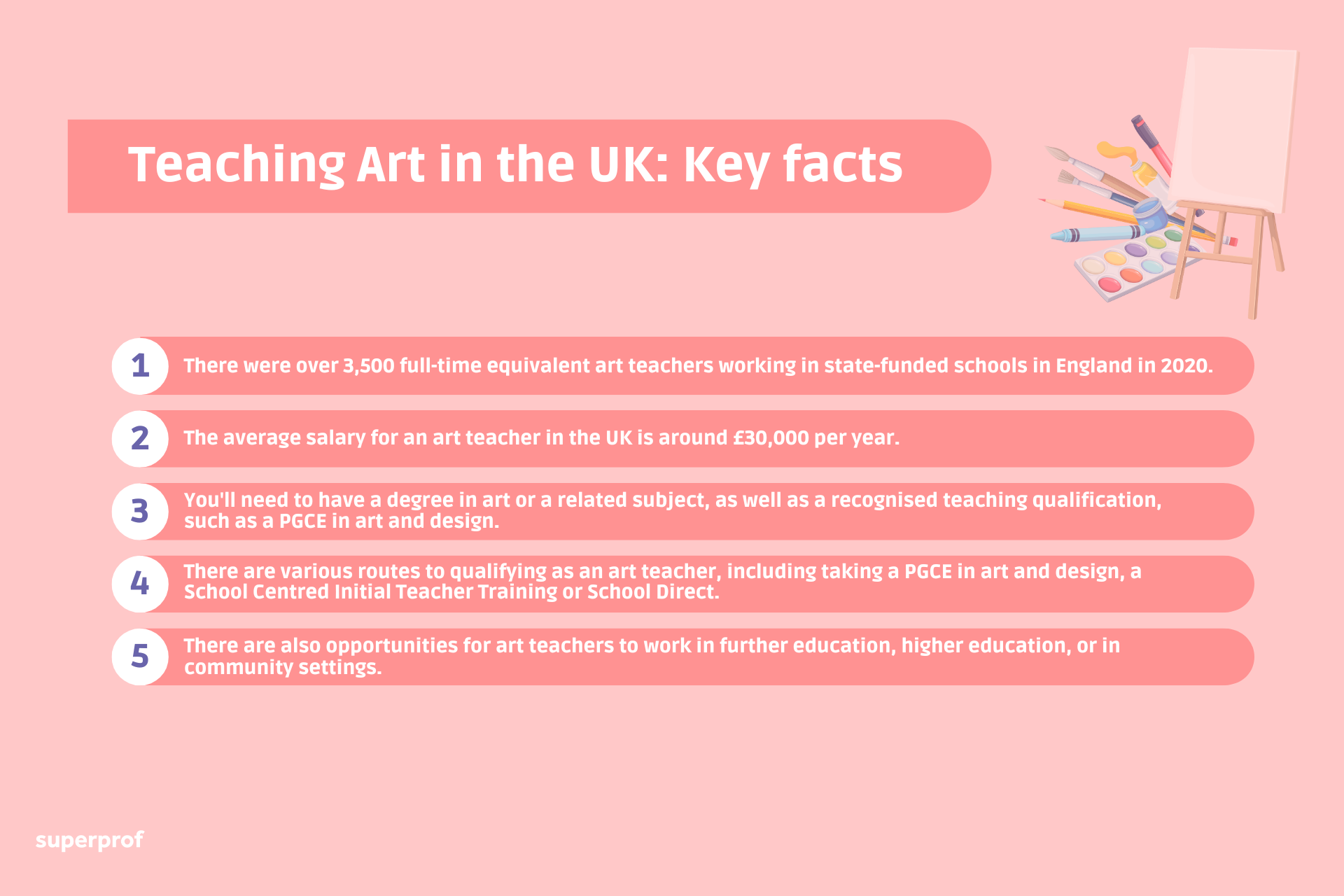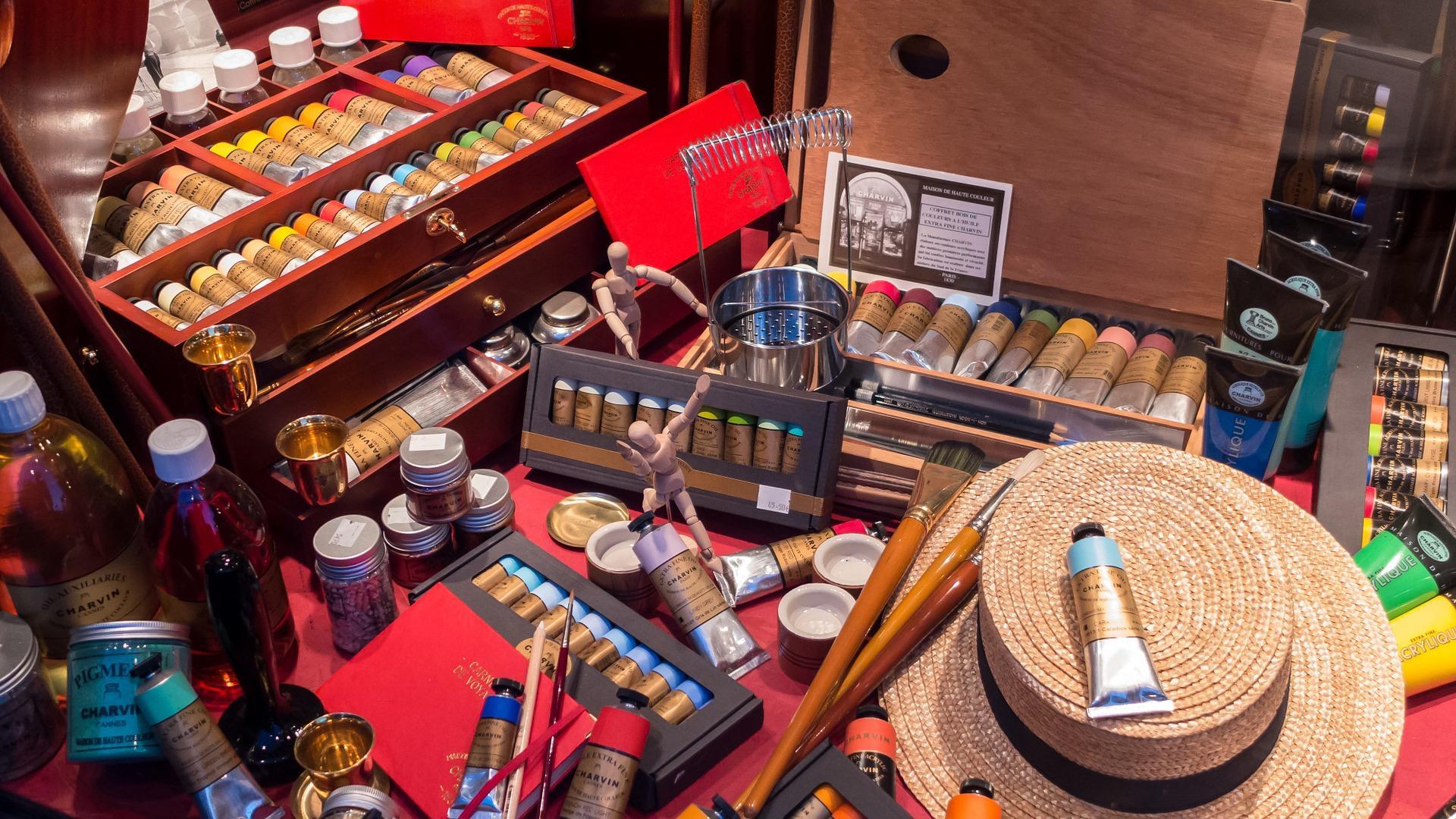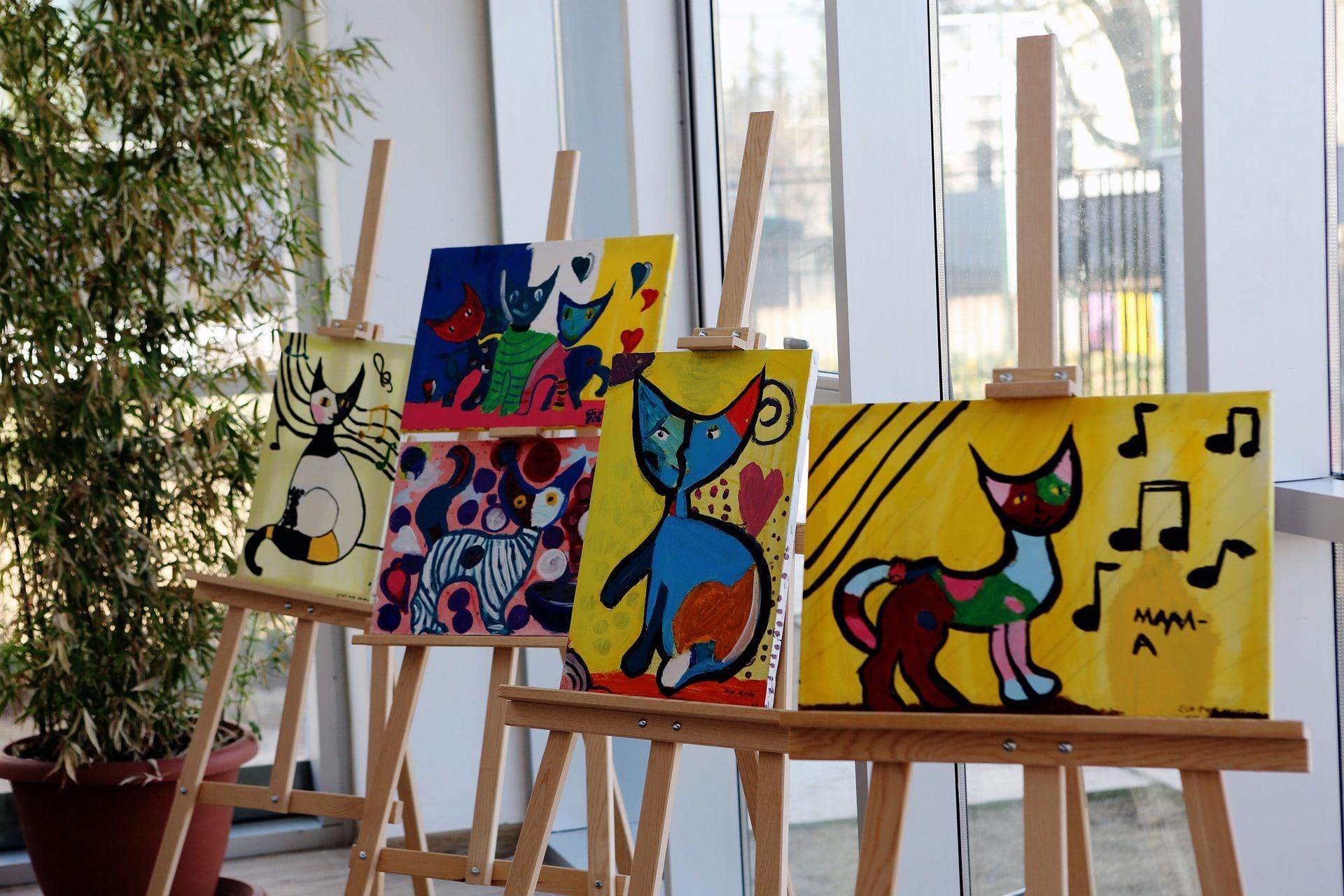You cannot teach a man anything, you can only help him find it within himself.
Galileo
If you have a passion for art and love teaching, becoming an art teacher can be a rewarding career. In this article, we'll explore how to become an art teacher in the UK, including the qualifications and training you'll need. We will also make a case for teaching, in general, and then, we’ll look at how important art education is to our student's development. Finally, we'll show you how you can become an art teacher.
The basic steps to becoming an art teacher are as follows:
- Study for an art degree or teaching qualification
- Complete a teacher training programme such as a PGCE in art and design or a SCITT programme
- Build your art portfolio
- Apply for teaching roles and complete your NQT year
- Plan your lessons and start teaching!
Want to give private lessons?
Join the Superprof community and share your knowledge with interested and motivated students.
Art Teacher Qualifications and Training

To become an art teacher, you'll need to have a passion for art and a desire to share your knowledge with others. You'll also need to be patient, creative, and able to communicate effectively with students of all ages and abilities.
If you don't have a degree in art, there are still options available to you. You can take an art foundation course to build up your skills and then apply for an art degree. Alternatively, you can take a conversion course, such as a Graduate Diploma in Art and Design, which will allow you to gain the necessary skills and knowledge to apply for a PGCE.
To become an art teacher in the UK, you'll need to have a degree in art or a related subject. You'll also need a recognised teaching qualification, such as a PGCE (Postgraduate Certificate in Education) in art and design. Alternatively, you can train to be an art teacher through a school-centred initial teacher training (SCITT) programme or School Direct.
There are various routes to become an art teacher in the UK. One option is to take a PGCE in art and design, which is a one-year teacher training programme. During the course, you'll learn how to teach art and design to students of all ages and abilities. You'll also gain practical teaching experience through placements in schools.
Another option is to train to be an art teacher through a SCITT programme or School Direct. These programmes allow you to gain practical teaching experience in a school while working towards a teaching qualification. You'll receive support and guidance from experienced teachers and mentors throughout the programme.
Becoming an art teacher in the UK requires a combination of qualifications, training, and passion for art. If you're committed to sharing your love of art with others and have the necessary skills and qualifications, then this could be the perfect career for you. Whether you're just starting out or looking to progress in your career, there are many opportunities available to you.
Teaching Art in the UK: Key Facts
Here are some statistics and information on becoming an art teacher in the UK:

How Do You Qualify as an Art Teacher?
Generally, art teachers will need postgraduate qualifications and qualified teacher status (QTS) to work in a secondary school in the UK.
However, first, they need a qualification in their subject area. Usually, this will be a bachelor's degree in art. Once they have this, they can complete postgraduate courses (usually the Postgraduate Certificate in Education or PGCE) or teacher training.
Most UK universities ask for a lower second-class undergraduate degree (2:2) in art and design-related subjects or equivalent for an art PGCE.
This table summarises the different routes to qualification as an art teacher and the requirements for each option:
| Route | Qualifications Required | Key Features | Leads to |
|---|---|---|---|
| Undergraduate Teaching Degree (BA/BEd with QTS) | A-levels (including Art or Design preferred) | Combines art education with qualified teacher status (QTS) | Primary or secondary art teacher |
| PGCE (Postgraduate Certificate in Education) | An undergraduate degree in Art or a related subject | 1-year course (full-time) or 2 years (part-time); includes school placements | QTS and art teaching qualification |
| School Direct (Salaried or Unsalaried) | A degree in a relevant subject, some school experience preferred | On-the-job training in a school, sometimes paid; includes PGCE/QTS | QTS and practical experience |
| Teach First | 2:1 or above in a relevant degree; leadership potential | Teach in challenging schools; earn a salary while training | QTS and leadership training |
| Assessment Only Route | Significant unqualified teaching experience | For experienced teachers without QTS; assessment of existing skills | QTS without additional training |
| SCITT (School-Centred Initial Teacher Training) | A degree in a relevant subject | School-based training led by a school partnership; includes PGCE/QTS | QTS with practical classroom focus |
| Apprenticeship (Postgraduate Teaching Apprenticeship) | A degree in a related subject | Earn while you train in a school; includes off-the-job training and QTS | QTS and workplace-based experience |
| Further Education Route | Art-related degree + PGCE (FE) or DET | For teaching post-16 learners in colleges; may not include QTS initially | Art teacher in further education |
Find out how to become an art teacher.
Want to give private lessons?
Join the Superprof community and share your knowledge with interested and motivated students.
Getting Onto An Art PGCE

To become a qualified teacher, you'll usually be expected to complete the PGCE in which you'll gain professional skills while studying and learning more about the teaching practice. Similarly, PGCEs include school-based work placements for aspiring teachers.
However, before you can do all this, you need to be accepted onto the course. Much like with undergraduate degrees and almost everything else in higher education, your application will be dealt with through UCAS.
Sadly, a PGCE isn't free but there are a few things you should know about the fees and funding. When you find a course and are accepted onto it, you should look to see whether or not you're eligible for a tax-free bursary, tuition fee loan or maintenance loan, or additional financial support. Bursaries go up to £9,000 and are available for those with a first, 2:1, 2:2, Master's, or PhD.
Before you start looking for a PGCE, we recommend that you check the QS World University Rankings to see which are the best universities. For example, certain universities are better for primary education while others excel in undergraduate study but fall short in postgraduate study. Similarly, most universities will sing their praises when it comes to their department of education or school of education.
You might want to also consider attending an open day once you've settled on a few universities that you're interested in.
Top PGCE Art Programmes in the UK
A PGCE (Postgraduate Certificate in Education) in Art and Design is a popular route for graduates who want to become qualified art teachers in the UK. This one-year postgraduate programme combines academic study with hands-on teaching experience, preparing you to teach in secondary schools. The course typically includes training in lesson planning, classroom management, and assessment methods, all while focusing on developing your subject knowledge in art and design. Upon successful completion, you’ll gain Qualified Teacher Status (QTS), allowing you to teach in state-maintained schools across England and Wales.
Below is a table outlining the different PGCE pathways available for aspiring art teachers:
| University | Program Description | Curriculum Highlights | Application Procedure |
|---|---|---|---|
| University of Cambridge | This program focuses on developing teaching skills in secondary school art and design. | - Subject knowledge enhancement - Pedagogical studies - Classroom management | - Bachelor's degree with relevant subject knowledge - Apply via UCAS - Interview |
| University College London (UCL) | UCL's PGCE in Art and Design prepares students to teach across the secondary school age range. | - Art and design education theory - Classroom practice - Professional studies | - Relevant undergraduate degree - Apply through UCAS - Interview process |
| University of Edinburgh | Focuses on contemporary art and design education in secondary schools. | - Curriculum planning - Assessment methods - Classroom observation and teaching practice | - Bachelor's degree in a relevant subject - Apply online via university website - Interview |
| University of Manchester | The program emphasizes innovative and inclusive teaching practices in art and design. | - Teaching methodologies - Art and design curriculum development - Reflective practice | - Relevant undergraduate degree - Apply through UCAS - Interview and portfolio review |
| University of Glasgow | A comprehensive PGCE program aimed at developing skilled secondary school art teachers. | - Subject-specific pedagogy - Inclusive teaching practices - Practical teaching experience | - Bachelor's degree with a focus on art - Apply via UCAS - Interview process |
| University of Leeds | This program integrates theoretical knowledge with practical teaching experience. | - Educational theory - Art and design teaching strategies - School placements | - Undergraduate degree in relevant subject - Apply online via university website - Interview and portfolio submission |
| University of Exeter | Focuses on preparing teachers for secondary education in art and design. | - Creative teaching methods - Classroom management - Professional development | - Relevant degree - Apply through UCAS - Interview and portfolio assessment |
| University of Birmingham | Emphasizes research-informed teaching practices and innovative pedagogy in art. | - Art education research - Pedagogical skills - Practical school experience | - Bachelor's degree in art or related field - Apply via UCAS - Interview and portfolio review |
| University of Nottingham | Provides comprehensive training for secondary school art teachers, with a focus on creativity and innovation. | - Creative pedagogies - Curriculum design - Classroom-based research | - Relevant undergraduate degree - Apply online via UCAS - Interview and portfolio submission |
Find out more about the qualifications art teachers need.
Passing the Art PGCE
In comparison to most degree courses, the PGCE can be tested. A lot is expected of those who want to make their way into primary or secondary education and teacher education in the UK reflects this. You'll be expected to study a lot!

As the PGCE is tough, make sure you rely on your support network. Friends, family, and, most importantly, university tutors and placement mentors are on hand to help you with guidance and assistance. If things get difficult and you start to struggle, make sure you reach out to those that can help you.
Similarly, you won't be the only person on your course so make sure that you make friends with the other PGCE students. After all, you're all in the same boat and it can be useful to work together as you all have shared goals. We're not saying that you should copy off them, but you should help each other and support one another.
One of the hardest parts of your PGCE will be the placement. While it's challenging, you should also try to make the most of it. We can't stress enough just how much you'll learn from this time and you should make sure that you're constantly learning from every challenge that's thrown your way.
The entry requirements for the PGCE might make you think that it's quite easy but it's quite the opposite. Ask anyone who's completed it and they'll tell you it was one of the toughest years of their lives. That said, it doesn't get much easier (or any easier) once they start working in primary or secondary schools. Teaching isn't for the faint of heart.
Find out how much art teachers earn.
Finding Work With an Art PGCE

Just because you've got your PGCE, it doesn't mean that you'll just automatically walk into a job teaching art in a state school. As we said earlier, you'll usually need an art degree, QTS, and, the hardest thing to get, experience.
When looking for work, you'll need to do your NQT first. NQT is short for "newly qualified teacher". This means that you've got your QTS but are yet to complete the "induction for newly qualified teachers", which is a 12-month programme.
Put simply, when you get your PGCE, your first year of teaching full-time will be your NQT year. This means that you'll need to be looking for NQT positions when applying. Once you've completed your NQT year, you can start searching for art teacher jobs of all types. However, like every other career, certain online tutoring jobs UK will require more experience than you have.
You can find jobs for art teachers on the gov.uk website under the teaching vacancies service. Similarly, jobs are posted to other sites like indeed.co.uk, totaljobs.co.uk, and teachin.co.uk, for example. Make sure that you apply to jobs that you're capable of doing and qualified for.
Find out what makes a good art teacher.
Like so many other career fields, the global teaching ranks are ageing out and not being replenished. This natural attrition is sounding alarm bells throughout the global educational community.
Study after study has shown the same trends. The information we cite comes from a 2018 report on Education International Research but there are many others, and they all say the same thing.
It's time we make a case for more teachers.
Check out teach English online jobs here.
Applying For Art Teacher Jobs
Once you’ve completed your PGCE and gained Qualified Teacher Status (QTS), you’ll be ready to start applying for art teacher positions—usually in secondary schools or further education settings. Here’s a step-by-step guide to help you navigate the application process as a newly qualified teacher:
1. Start Your Search Early
Begin looking for jobs during your PGCE year, especially from January onwards, as many schools begin recruiting for the next academic year in spring and early summer. Websites like TES Jobs, Eteach, Guardian Jobs, and local council job boards are good places to start.
2. Prepare a Strong CV and Personal Statement
Your CV should highlight:
- Your degree and PGCE details
- School placements and relevant teaching experience
- Skills in classroom management, lesson planning, and assessment
- Your passion for art and education
Include a tailored personal statement for each application. Focus on your teaching philosophy, what you bring to a department, and how your art specialism enhances student learning.
3. Register with Teacher Recruitment Agencies
Many recruitment agencies specialise in helping NQTs find roles. They can support with interview preparation and match you with schools that suit your teaching style and subject.
4. Attend Recruitment Fairs and School Open Days
Teacher recruitment events and school taster days are great opportunities to meet hiring managers and learn about different schools' cultures and expectations.
5. Prepare for Interviews and Teaching Demos
Most interviews include:
- A lesson observation or teaching demonstration
- A formal interview with senior staff
- A tour of the school
Practice delivering a creative and engaging art lesson—showcase your classroom presence, ability to differentiate, and passion for the subject.
6. Highlight Your Commitment to Professional Development
As an NQT, show enthusiasm for continuous learning, including participation in induction training, departmental meetings, and CPD (Continuing Professional Development).
Where Can You Work As A Newly Qualified Art Teacher?
As a qualified art teacher, you’ll find opportunities in a variety of educational settings across the UK. Here are some of the most common options:
| Setting | Description | Key Features |
|---|---|---|
| Secondary Schools | State-funded schools following the National Curriculum | Teach Key Stages 3–5, including GCSE and A-Level Art and Design |
| Academies and Free Schools | Publicly funded but independently run schools | Often offer creative flexibility, may focus on the arts |
| Independent (Private) Schools | Privately funded schools with their own curriculum | Smaller class sizes, greater emphasis on extracurricular art activities |
| Further Education (FE) Colleges | Post-16 institutions offering vocational and academic qualifications | Teach BTEC, A-Level, or foundation art courses; PGCE (FE) or DET required |
| Specialist Art or SEN Schools | Schools focused on creative arts or special educational needs | Support inclusive education; may involve art therapy or alternative teaching methods |

Completing Your NQT/ECT Year
From 2021 onwards, the traditional NQT year has been replaced with the Early Career Teacher (ECT) induction, which lasts two years. Here’s what you need to know:
What to Expect:
- Support from a mentor and a dedicated induction lead
- A reduced teaching timetable in your first year (typically 90%)
- Structured professional development and training
- Regular observations, feedback, and progress reviews
How to Pass Your ECT Induction:
- Meet the Teachers’ Standards consistently
- Reflect on feedback and show clear progress
- Take part in CPD sessions and whole-school activities
- Build strong relationships with staff and students
- Keep track of your achievements and development in a portfolio
Once you’ve successfully completed your two-year ECT programme, you’ll be a fully qualified teacher with no further induction required—ready to build your long-term teaching career in the arts!
The Realities Of Working As An Art Teacher
Working as an art teacher can be incredibly rewarding, but it also comes with its unique set of challenges. You'll have the chance to inspire creativity, support self-expression, and watch students grow in confidence through their artistic abilities. However, art teachers often face tight budgets for materials, time constraints due to packed timetables, and the need to balance creative freedom with curriculum targets. Displaying and assessing creative work can also be time-consuming, especially during exam periods. Despite this, many art teachers find the role fulfilling because of the meaningful connections they build with students and the creative energy it brings to their day-to-day teaching.
See how you can become a tutor London here.
Want to give private lessons?
Join the Superprof community and share your knowledge with interested and motivated students.






